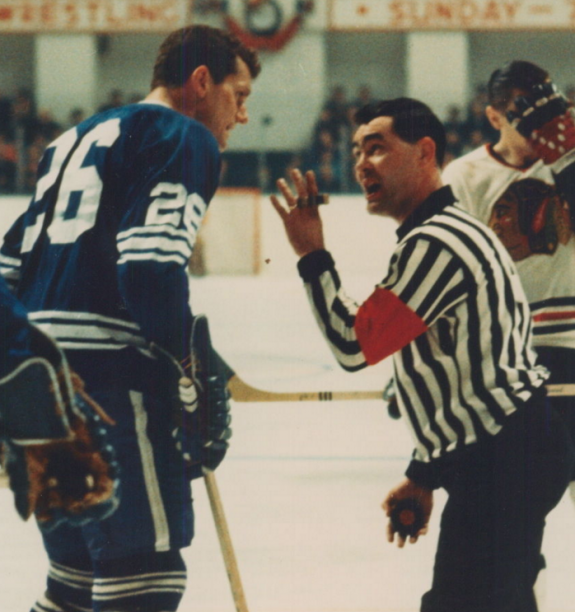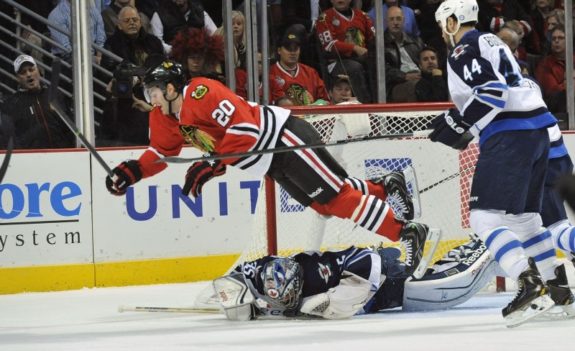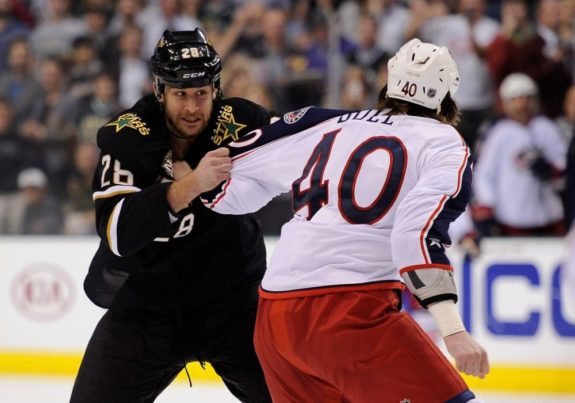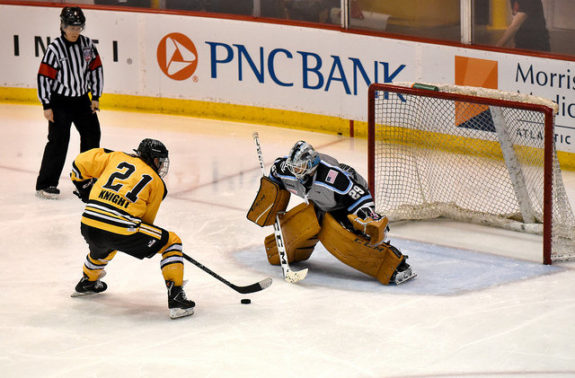*This is part of our Hockey 101 series geared towards the newer fan that needs a primer on the game.
During the course of play, it is not uncommon for a player to commit an illegal act. These are known as penalties. The many different penalties will be discussed in other articles. However, the types of hockey penalties that can be called require some in-depth explanation of their own.

Delayed Penalties
When a penalty is committed, one of the two referees (those who determine penalties) will raise their arm in the fashion shown above. This is called a delayed penalty. If the offending team does not have possession of the puck, play will continue until they do or the puck is out of play. In these moments, the team that was the victim of the penalty can effectively pull their own goalie and add an extra skater because the other team cannot control the puck without play being stopped and the penalty assessed.
The Types of Hockey Penalties
Minor
The most common types of penalties are minor penalties. The vast majority of infractions in the NHL Rule Book are minor penalties. If assessed a minor penalty, the offending player will spend two minutes in the penalty box and his team will play short-handed (only four skaters). The penalty time is up if the team at full strength scores a goal or the two minutes expires. A team can be assessed multiple minor penalties at the same time. In these situations, the offending team will play doubly short-handed (5-on-3). If the other team scores one goal, the first offending player is released but the other player remains in the box.

Double Minor
A double minor is assessed for an act deemed more egregious than a minor and specific to certain penalties. Head-butting, spearing, butt-ending, or high sticking that results in blood are penalties that earn double minor status. These penalties get four minutes in the penalty box. The key difference in a double minor power play and a minor power play is the result of a goal scored. If a single goal is scored, the offending player is not released. In a way, it only washes out one of the “double.” Scoring two goals during the four minute span will release the player.
Bench Minors
A bench minor is a penalty assessed to a player or coach not currently on the ice. Too Many Men and Unsportsmanlike Conducts can come from the bench. In this situation, a player will serve the two minute penalty that is served like a regular minor.
Coincidental Penalties
The first type of penalty that does not result in a team going short-handed is the coincidental. These are fouls that happen in the same event. For instance, a scrum occurs and two players go too far in the rough stuff; the offenders will go to the box for two minutes but both teams will remain at full strength. The offenders will be released on the first stoppage of play after they have served the two minutes.
Major
The types of hockey penalties that incur five minutes in the penalty box are called major penalties. The most common major penalties are for fighting. No matter the penalty itself, a major penalty puts that player out of the game for five minutes. In a situation where coincidental majors (fighting), neither team will play shorthanded (five-on-five continues). If there is a standalone major penalty, the offending team will be shorthanded for five minutes no matter how many goals the opposing team scores.

Match Penalties
A match penalty is the NHL equivalent of an ejection. On record, it goes down as a ten-minute penalty; however, the player is sent to the dressing room for the rest of the game. His team will play shorthanded for five minutes under the same rules as a major. Match penalties are used to punish a player that tries to or successfully injure another player intentionally.
Misconduct and Game Misconducts
A misconduct penalty is a less severe version of the match penalty. A player is not entirely ejected but is sent off the ice for ten minutes. In this time, his team is not shorthanded unless he was also assessed a minor, major, or match penalty. Misconducts are generally for behaviors that involve verbal abuse or other emotional outbursts. A game misconduct, however, is a match penalty (automatic ejection) without the team going shorthanded. A game misconduct always garners a fine and can even earn a further suspension.
Penalty Shots
A special scenario is given when a penalty is committed that takes away a genuine scoring opportunity. In a play when an attacking player is in either the neutral or attacking zone, has no defender in between him and the goal, the foul occurs from behind, and the attacking player has clear possession of the puck he will be awarded a penalty shot. A penalty shot is a one-on-one showdown between the offended player and the opposing team’s goalie. If he does not score, there is no power play and the game continues. If he scores, well, obviously his team earns another goal.
